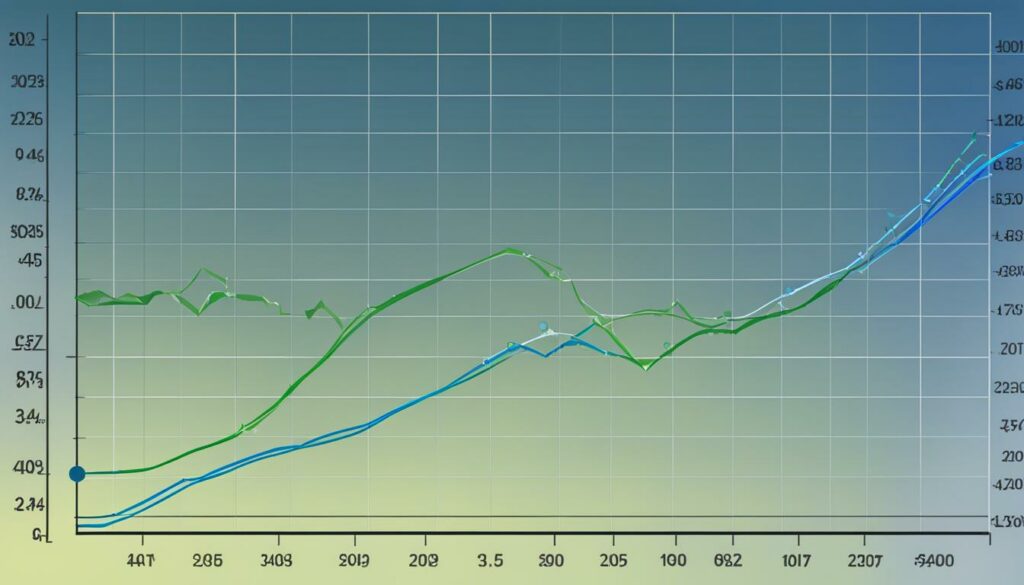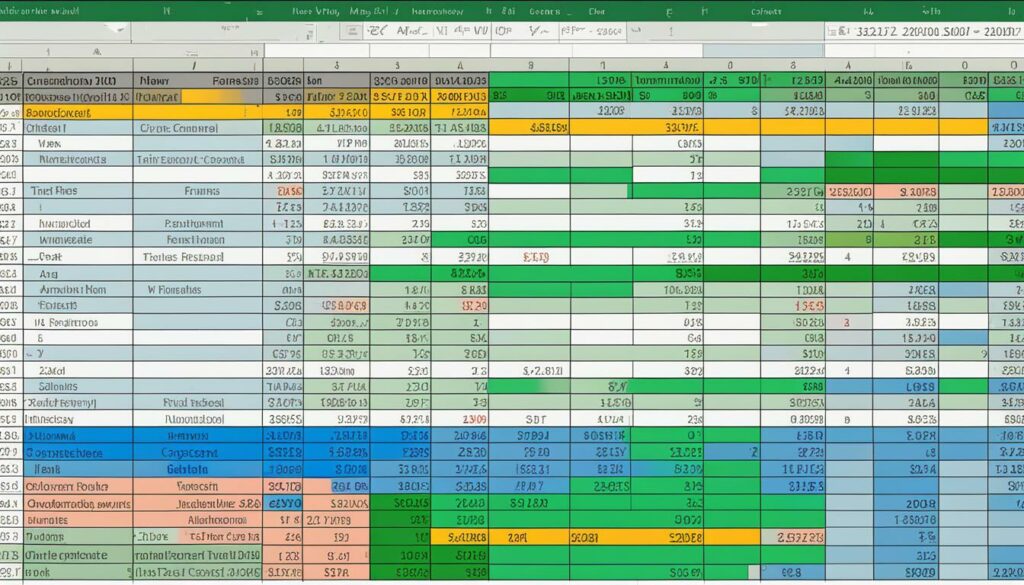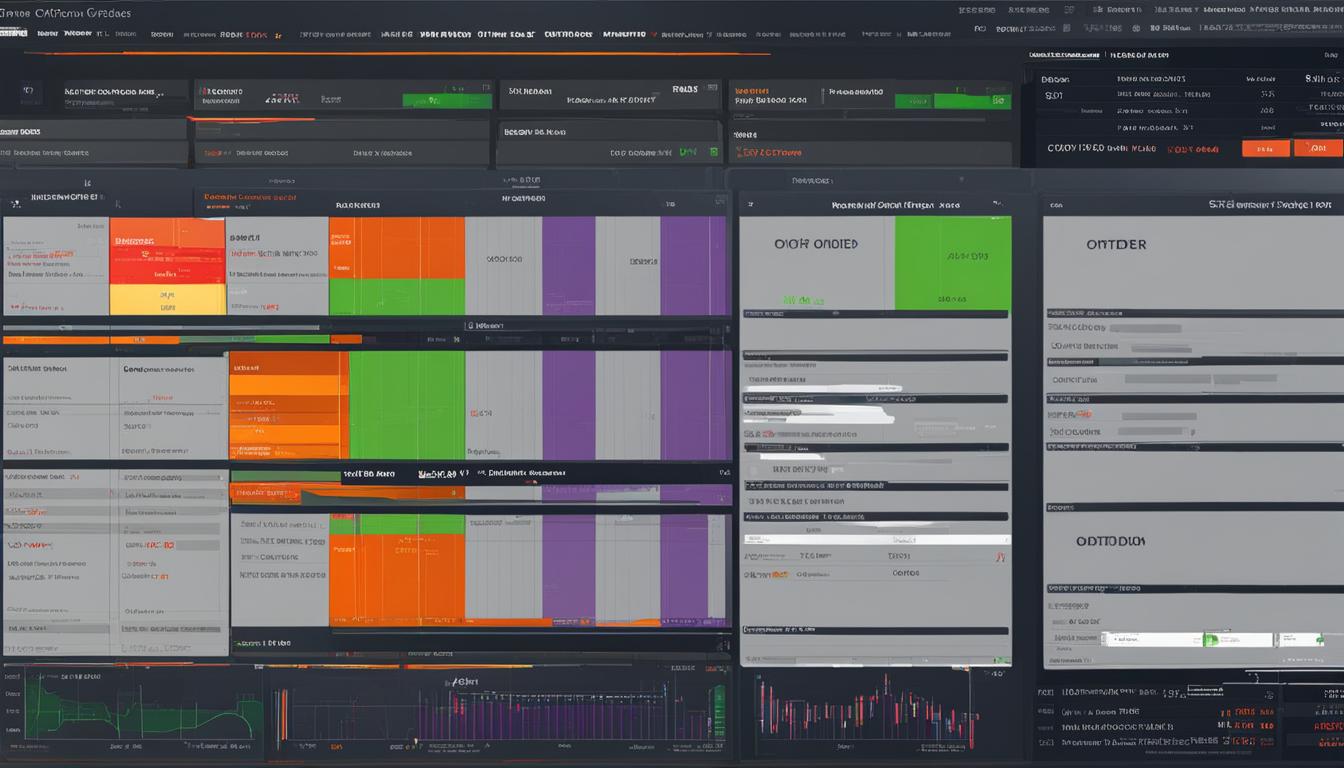Intrinsic Value: When Options Expire Nothing Else Matters

The intrinsic value of an option becomes crucial when the option reaches its expiration date. Understanding the concept of intrinsic value is essential for making informed investment decisions. Intrinsic value is determined by factors such as the price of the underlying security and the option’s strike price. The Black-Scholes model is commonly used to calculate the intrinsic value of an option.
Key Takeaways:
- Intrinsic value plays a crucial role in options trading and investment decisions.
- Factors such as the price of the underlying security and the option’s strike price determine the intrinsic value.
- The Black-Scholes model is commonly used to calculate the intrinsic value of an option.
- Understanding intrinsic value is essential for making informed investment decisions.
- Options pricing is influenced by the concept of intrinsic value.
The Importance of Time Value in Option Pricing
When it comes to option pricing, understanding the concept of time value is essential. Time value is the portion of an option’s price that is not attributed to its intrinsic value. Instead, it reflects the potential for the option to gain value before it expires. The longer the time remaining until expiration, the higher the time value of an option.
Traders use various option pricing models, such as the Black-Scholes model, to determine the time value of an option. These models take into account factors such as the underlying asset’s volatility, interest rates, and time remaining until expiration. By calculating the time value, traders can make informed decisions about their option strategies.
Understanding time value is crucial for evaluating different option strategies and calculating the intrinsic value of options. Traders need to consider not only the potential for the option to be profitable at expiration but also the time value that may be lost as the option approaches its expiration date. By carefully assessing the time value, traders can make strategic choices that align with their investment goals.
The Role of Time Value in Option Strategies
Time value plays a significant role in option strategies. When developing an options trading strategy, traders need to consider the potential for the option’s time value to decay over time. Options with a longer time to expiration generally have higher time values, providing more potential for profit. On the other hand, options with shorter time to expiration have lower time values, making them riskier.
Traders may choose to implement strategies that take advantage of time value decay, such as writing covered calls or selling vertical spreads. These strategies aim to capture the premium from the time value decay, allowing traders to potentially profit even if the underlying asset’s price doesn’t move significantly.
| Option Strategy | Description |
|---|---|
| Covered Calls | Selling call options against a long position in the underlying asset. |
| Vertical Spreads | Buying and selling options of the same type (either calls or puts) with different strike prices. |
Understanding time value is crucial for evaluating different option strategies and calculating the intrinsic value of options.
By incorporating time value into their trading strategies, traders can optimize their potential for profit and manage their risk effectively. It is essential to stay updated on market conditions and employ appropriate risk management techniques when trading options to mitigate potential losses.
In conclusion, time value is a critical component of option pricing. Traders must consider the time remaining until expiration and the potential for the option to gain value during that period. By understanding the role of time value in option strategies, traders can make informed decisions and implement strategies that align with their investment goals.

Concepts of Moneyness and Option Position
The concepts of moneyness and option position are fundamental to understanding the intrinsic value of options and making informed decisions in options investing.
Moneyness refers to the relationship between an option’s strike price and the current market price of the underlying security. It helps determine whether an option is in the money, out of the money, or at the money.
An option with intrinsic value is in the money, meaning its strike price is favorable compared to the current market price. This suggests that exercising the option immediately would yield a profit. On the other hand, an option that is out of the money has no intrinsic value and is not profitable to exercise at the current market price.
Understanding moneyness is crucial for evaluating the intrinsic value of options. It helps options traders identify opportunities to profit from options with intrinsic value, while also assessing the risks associated with options that are out of the money.
Option position refers to the ownership or obligation involved in holding an option. Depending on whether an investor holds a call option or a put option, the option position can have different implications when the option expires.
When a put option expires in the money, the option holder can sell the underlying asset at the strike price or initiate a short position in the market. On the other hand, if a call option expires in the money, the option holder automatically purchases the underlying asset at the strike price.
Understanding the outcomes when options expire in the money is crucial for managing option positions effectively and making informed investment decisions. It allows options traders to capitalize on profitable opportunities and mitigate potential losses.

| Moneyness | Definition |
|---|---|
| In the money | An option with intrinsic value |
| Out of the money | An option with no intrinsic value |
| At the money | An option with a strike price equal to the current market price |
Option Position Outcomes:
- Put options: When a put option expires in the money, the option holder can sell the underlying asset at the strike price or initiate a short position in the market.
- Call options: When a call option expires in the money, the option holder automatically purchases the underlying asset at the strike price.
“Understanding moneyness and option position is crucial for evaluating options with intrinsic value and making informed investment decisions.”
Time Value Decay and Its Impact on Option Pricing
Time value decay, also known as theta, is a crucial concept in option pricing. It refers to the gradual reduction in an option’s time value as it approaches its expiration date. This decay occurs because as time passes, the likelihood of the underlying asset experiencing significant price swings decreases. As a result, the potential for the option to gain value diminishes, leading to a decrease in its premium.
To better understand the impact of time value decay on option pricing, traders often utilize option pricing formulas and calculators. These tools help assess the decrease in an option’s time value over time and provide insights into the option’s potential profitability. The Black-Scholes model is one commonly used option pricing formula that incorporates time value decay into its calculations.
Understanding the dynamics of time value decay is essential for conducting intrinsic value analysis. Traders need to take into account the diminishing time value when evaluating the potential profitability of an option. By assessing the rate of decay, traders can make more informed decisions regarding the optimal timing for entering or exiting an options position.
The Impact of Time Value Decay in Option Pricing
Time value decay has a significant impact on both buyers and sellers of options. For buyers, the decay erodes the value of the option over time, making it important to monitor the rate of decay and the remaining time to expiration. On the other hand, option sellers can benefit from time value decay as the premium they received when selling the option diminishes over time, potentially leading to profits.
Traders should be aware that time value decay is not linear and accelerates as the option’s expiration date approaches. Therefore, it is crucial to consider the time remaining until expiration when evaluating option strategies and pricing. The effects of time value decay can vary depending on factors such as the volatility of the underlying asset and the specific option strategy employed.

| Option Pricing Formulas | Advantages | Disadvantages |
|---|---|---|
| Black-Scholes Model | Provides a theoretical framework for option pricing | Assumes constant volatility and other simplifying assumptions |
| Binomial Model | Allows for flexibility in modeling different price movements and volatility | Can be computationally intensive for complex options |
| Monte Carlo Simulation | Can capture complex price movements and volatility | Requires significant computational resources and may introduce simulation errors |
In conclusion, understanding the dynamics of time value decay is essential for evaluating option pricing and making informed trading decisions. Traders should consider the rate of decay, the remaining time to expiration, and the specific option pricing formulas to assess the potential profitability of an option. By incorporating time value decay into their analysis, traders can optimize their option strategies and minimize the impact of diminishing time value on their positions.
The Potential of Zero-Day Options
Zero-day options, also known as same-day options, are a type of options contract that expires on the same day it is issued. These options can offer significant profit potential for traders, especially when there are significant price movements in the underlying asset on the option’s last day. Zero-day options are typically out of the money (OTM) options, meaning that the current market price of the underlying asset is below the option’s strike price.
Traders are increasingly attracted to zero-day options due to their amplified profit potential through leverage and low time value cost. Since zero-day options have a very short time frame, they are highly leveraged and can provide quick returns if the price moves in the trader’s favor. However, it is important to note that zero-day options can also result in the loss of the entire investment if the price does not move favorably. This makes them a speculative strategy that should only be used by experienced traders who can closely monitor market conditions and make quick decisions.

When trading zero-day options, it is crucial to consider factors such as volatility, the time remaining until expiration, and the potential for price movements in the underlying asset. Traders should have a solid understanding of options trading strategies and risk management techniques. Proper risk assessment and position sizing are essential to minimize potential losses and maximize profits when trading zero-day options.
Key Points:
- Zero-day options expire on the same day they are issued.
- They can provide significant profit potential through leverage and low time value cost.
- Zero-day options are highly speculative and should be traded by experienced individuals who can closely monitor market conditions.
- Understanding options trading strategies and risk management techniques is crucial when trading zero-day options.
Conclusion:
Zero-day options offer traders the potential for quick profits, but they also come with higher risks. Traders must carefully consider market conditions and implement effective options trading strategies to maximize their chances of success. It is essential to have a clear understanding of the potential outcomes and risks associated with trading zero-day options before engaging in this speculative strategy.
Trading Zero-Day Options
Trading zero-day options requires a solid understanding of various options trading strategies. These strategies help traders navigate the unique characteristics of zero-day options and maximize their profit potential. Here are some key strategies to consider:
1. Short-Term Price Movements:
Zero-day options thrive on short-term price movements. Traders should identify assets that are likely to experience significant price swings on the option’s last day. By closely monitoring market conditions and technical indicators, traders can make informed predictions about potential price movements. This information can help determine which zero-day options to trade and when to enter or exit positions.
2. Volatility Analysis:
Volatility is a crucial factor in zero-day options trading. Traders should assess the implied volatility of the underlying asset to determine the potential for price volatility on the option’s expiration day. Options with higher implied volatility offer greater profit potential but also come with higher risks. Traders can use volatility analysis tools to identify opportunities and create effective trading strategies.
3. Risk Management:
Zero-day options carry inherent risks due to their short time frame. Traders must implement robust risk management strategies to protect their capital. This includes setting stop-loss orders to limit potential losses and defining profit targets to secure gains. It is essential to establish risk-reward ratios that align with personal risk tolerance and trading objectives.
| Zero-Day Option Trading Strategies | Key Considerations |
|---|---|
| Trend Following | Identify assets with clear trends and trade based on the direction of the trend. Consider using technical indicators to confirm trend reversals. |
| Momentum Trading | Look for assets with high momentum and enter positions when the price is moving strongly in a particular direction. Keep a close eye on volume and news catalysts. |
| Breakout Strategies | Trade breakouts above resistance levels for call options or below support levels for put options. Confirm breakouts with high volume and strong price action. |
4. Position Sizing:
Proper position sizing is crucial when trading zero-day options. Traders must determine the appropriate amount of capital to allocate per trade to manage risk effectively. This involves considering factors such as account size, risk tolerance, and the probability of success. Implementing a position sizing strategy helps ensure consistency and protects against substantial losses.
Remember, trading zero-day options requires experience and careful analysis. It is advisable to start with small positions and gradually increase exposure as confidence and expertise grow. By continually refining strategies and staying updated on market developments, traders can increase their chances of success in the exciting world of zero-day options.

What Happens When Option Expires In the Money
When a put option expires in the money, the option holder has two choices available. They can either exercise the option to sell the underlying asset at the strike price or initiate a short position in the market. By exercising the put option, the option holder can take advantage of the option’s intrinsic value and sell the asset at a profit. Alternatively, if the option holder decides not to exercise the option, they can initiate a short position by selling the options contract in the market.
On the other hand, when a call option expires in the money, the option holder automatically purchases the underlying asset at the strike price. This means that if the market price of the asset is higher than the strike price, the option holder can buy the asset at a discounted price. It is important to note that these outcomes depend on whether the option holder owns the underlying asset or not. If the option holder does not own the underlying asset, they will need to buy it in order to fulfill the obligations of the in-the-money call option.
Understanding the outcomes when options expire in the money is crucial for managing option positions effectively. It allows option holders to make informed decisions about whether to exercise the option, initiate a short position, or fulfill their obligations as call option holders. By considering factors such as the current market conditions, the potential profitability of exercising the option, and their own investment goals and strategies, traders can maximize their returns and minimize their risks when dealing with options that expire in the money.
| Outcome | Put Option Expiring In The Money | Call Option Expiring In The Money |
|---|---|---|
| Option Holder’s Choice | Exercise option to sell underlying asset at strike price or initiate a short position | Automatically purchase underlying asset at strike price |
| Intrinsic Value | Option holder can take advantage of the option’s intrinsic value | Option holder can buy the asset at a discounted price |
Managing options that expire in the money requires careful consideration and analysis. By understanding the available choices and potential outcomes, option holders can make informed decisions that align with their investment strategies and goals. Whether choosing to exercise the option, initiate a short position, or fulfill their obligations as call option holders, having a clear understanding of the options’ intrinsic value and market conditions is essential for successful options trading.
Losing Money with Expired Options
When it comes to trading options, there is always the risk of losing money if the options expire out of the money. This means that the options do not have any intrinsic value and are essentially worthless at expiration. If you have bought options that expire out of the money, you can lose the entire amount that you spent on purchasing those options.
On the other hand, if the options expire in the money, you have a few options to consider. You can sell the options before they expire to lock in any profits you may have, or you can choose to exercise the options and either buy or sell the underlying asset at the predetermined strike price.
It is important to note that selling options, also known as writing options, can come with its own set of risks. When you sell options, you are essentially taking on the obligation to buy or sell the underlying asset if the option holder decides to exercise their rights. This means that you may be required to buy or sell the asset at a price that is not favorable to your original investment strategy.
Before entering into any options trading strategy, it is essential to fully understand the potential outcomes and risks associated with expired options. Careful consideration of your investment goals, risk tolerance, and market conditions is necessary to make informed decisions. It may also be beneficial to consult with a financial advisor or professional who specializes in options trading to ensure that you are making the best choices for your portfolio.
| Pros of Selling Options | Cons of Selling Options |
|---|---|
| Opportunity to generate income through premium collection | Potential for unlimited losses if options are not managed properly |
| Ability to take advantage of time decay and reduced option values | Obligation to buy or sell the underlying asset if options are assigned |
| Potential for higher success rates compared to buying options | Limited profit potential compared to buying options |
In conclusion, it is crucial to carefully evaluate the outcomes and risks associated with expired options. Whether buying or selling options, understanding the potential losses and profits is essential for managing your portfolio effectively. Consider your investment goals, risk tolerance, and market conditions before entering into any options trading strategy.

Conclusion
Understanding the intrinsic value of an option is crucial for making informed investment decisions. By considering factors such as moneyness, time value decay, and the potential of zero-day options, traders can accurately evaluate an option’s intrinsic value and assess its profitability.
Investors must also take into account various option pricing models and implement effective option trading strategies to maximize profits and minimize risks. Analyzing the potential outcomes when options expire in-the-money allows for efficient management of option positions.
In conclusion, evaluating option expiration, considering the intrinsic value, and understanding the impact of time value are key elements in successful options trading. By carefully analyzing these factors, traders can make informed investment decisions and increase their chances of achieving profitable outcomes.
FAQ
What is the intrinsic value of an option?
The intrinsic value of an option is determined by factors such as the price of the underlying security and the option’s strike price.
How is the intrinsic value of an option calculated?
The Black-Scholes model is commonly used to calculate the intrinsic value of an option.
What is time value in option pricing?
Time value is the portion of an option’s price that is not attributed to its intrinsic value. It reflects the potential for the option to gain value before it expires.
How is time value of an option determined?
The longer the time to expiration, the higher the time value of an option. Traders use option pricing models to determine the time value of an option, such as the Black-Scholes model.
What is moneyness in options trading?
Moneyness refers to the relationship between an option’s strike price and the current market price of the underlying security. It determines whether an option is in the money, out of the money, or at the money.
How is moneyness determined?
An option with intrinsic value is in the money, meaning it would be profitable to exercise the option immediately. This is determined by comparing the strike price to the current market price.
What is time value decay?
Time value decay, also known as theta, refers to the reduction in an option’s time value as it approaches its expiration date.
How does time value decay affect an option’s price?
As time passes, the potential for the underlying asset to have a significant price swing diminishes, causing the option’s premium to decrease.
What are zero-day options?
Zero-day options are regular options that expire on their last day of existence. They can provide significant profit potential, especially when there are significant price movements in the underlying asset on the option’s last day.
What do traders need to consider when trading zero-day options?
Traders must consider factors such as volatility, time remaining until expiration, and the potential for price movements in the underlying asset. Zero-day options provide opportunities for significant gains within a short time frame but come with higher risks.
What happens when a put option expires in the money?
The option holder can either exercise the option to sell the underlying asset at the strike price or initiate a short position in the market.
What happens when a call option expires in the money?
The option holder automatically purchases the underlying asset at the strike price.
What are the potential outcomes when options expire out of the money?
If an investor buys an option and it expires out of the money, they can lose the entire amount spent on purchasing the option.
What are the potential outcomes when options expire in the money?
If an option expires in the money, the investor can sell or exercise the option to lock in any profits.
What is the importance of understanding the outcomes of expired options?
It is important to understand the potential outcomes and risks associated with expired options, whether buying or selling, to effectively manage option positions.







